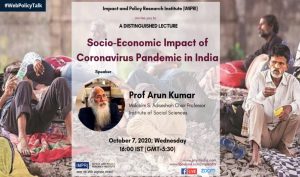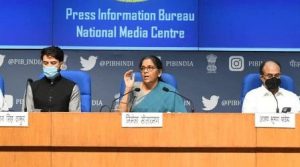COVID-19 Bonds Needed for Socio-Economic Revival in India
Political scientists and politics should lead towards the stipulated changes for the betterment of Indian economy and society.
A second wave of COVID-19 during the winters, while the numbers in the first round are soaring due to lack of testing facilities, would be worrying. Since vaccine will take time, the  consumption and investment would remain low. Production can undergo a V shaped recovery as claimed by the Ministry of Finance, but that was unlikely because there are real costs attached to economic activity where businesses have exhausted working capital and banks’ own financial conditions are deteriorating, therefore the recovery is expected to be a K shape, wherein some sectors like IT will do good and others such as tourism will be heavily affected. The slower the rate of recovery of the economy and more negative would be the GDP growth rate. The decline was around 50 per cent instead of 23 per cent in the output of the economy as claimed by NSO data.
consumption and investment would remain low. Production can undergo a V shaped recovery as claimed by the Ministry of Finance, but that was unlikely because there are real costs attached to economic activity where businesses have exhausted working capital and banks’ own financial conditions are deteriorating, therefore the recovery is expected to be a K shape, wherein some sectors like IT will do good and others such as tourism will be heavily affected. The slower the rate of recovery of the economy and more negative would be the GDP growth rate. The decline was around 50 per cent instead of 23 per cent in the output of the economy as claimed by NSO data.
The GDP in April 2020 was 25 per cent less compared to the GDP of 2019. So, with an optimistic assumption that if the economy falls by 30 per cent then GDP will come down to 145 lakh crores from 204 lakh crore as estimated last year. Unfortunately, this year’s calculations are based on 204 lakh crores instead of 145 lakh crores. Last year’s GDP is difficult to achieve this year. Hence, the additional investment required to build health infrastructure and provide unemployment support to the poor should come from this 145-lakh crore of the economy.
When the economy declines, so does the tax collections. This year’s budget was based on expectation that the economy will grow at 10 per cent, but as the economy fell by 30 per cent, the tax collections collapsed by more than 40 per cent. Revenues of states and centre will fall to 12 per cent of GDP from 16.5 per cent.
The current expenditure plans by governments are unsustainable and new expenditure plans would only add to miseries.
Also Read : COVID-19 Pandemic: Socio-Economic Impact in India
Government has obligations of past such as interest payments which cannot be withheld, and thus to meet these expenses, the government must reduce the expenses of salaries, defence, travels and meetings, etc. Another way is to reduce expenses on new projects and postpone public investments, but this will further reduce the demand. Fiscal deficit is bound to increase owing to revenues shortages.
The package of 20 lakh crore announced by the government is supply oriented. Only 2 lakh crore are coming from the budget and the rest amount is dependent upon loans and credibility, for instance, the Minister of Finance mentioned that 8 lakh crore would come from RBI liquidity. Immediate relief is only 2 lakh crore which is very small against 18 lakh crore that is required. Further, the supply side responses are for the medium- and long-run and not short-run, which is an immediate requirement. The privatisation of the public sector was a pro-corporate step with requirement of strengthening of the public sector. Merging of micro units with medium and large units will only benefit the latter under the fiscal package of 3 lakh crore.
Atma Nirbhar Bharat contradicts its own objective of attracting foreign capital. Corporatisation of agriculture with the family of three bills will put the farmers into misery since corporates will be trading as aggregators. There will be double margins squeezing out small farmers.
The ethical aspects of the coronavirus pandemic are that the marginalised are pushed farther than the margin and they are not able to cope with crisis. Cottage sector will be affected badly. Policymakers are always focused on short- and medium-term solutions for organised sector.
Series of initiatives such as demonetization, NBFC crisis and digitisation of the economy have always affected the marginalised. Policymakers have seen informal workers as labourers for homes and businesses and act as reserve army of labour to keep the wages down in the organised sector and economy. This leads to a situation where masses of people in the unorganised sector do not have living wages and they live in deplorable conditions. Since viruses keep coming, there is a need for survival package, but the survival package is designed in such a way that workers migrate back to cities. The cheap labour for homes and businesses attracted them since the MGNREGA scheme is  not strengthened. Workers are in a limbo since neither cities’ have started work nor rural have work opportunities. This is further increasing the marginalisation in employment, education and health.
not strengthened. Workers are in a limbo since neither cities’ have started work nor rural have work opportunities. This is further increasing the marginalisation in employment, education and health.
While restarting the economy, the full capacity level of the economy will be lower than pre-pandemic levels and people have to maintain physical distancing. Resource generation would be less. Poor and the unorganised sector need support through an expanded public distribution system. There is a need for collectively tackling alienation of the marginalisation. Disease does not respect boundaries; thus, vaccination is required for all including the marginalised. There is a need to step up the health infrastructure. Public goods are to be provided in the country by spending more on education, water, etc., to prevent societal crisis. Resource position of governments is poor, thus, there is a need to redo the budget. Since the centre and states both are suffering, they need to focus on the survival package.
Once the pandemic is tackled, there is a need to rethink the basic development paradigm to tackle inequality, nature of trade, environment and openness of the economy.
Also Read : Women Farmers’ Day on 15th October: Modi Government to Miss the Day Again?
There is a need for robust opposition that forces to rethink new ideas which is decimated now. For an independent policy for poor in India, we have to come out of the grip of international finance capital since financial sector controls the economic fluctuations. Capital is dominant in nature since it is more mobile than labour.
Post-pandemic situation will have more unemployment since companies will adopt a lot of automation and many companies will feel that they would need less workers. Disparities will increase in education and health due to increasing digitisation. Women will be worst sufferers leading to decreasing workforce participation. Violence against women is an emerging facet. Consumption basket is more about essentials rather than non-essentials. Data reveal that wholesale price index is declining, and consumer price index is rising creating temporary inflation situation, suggesting that the traders are hoarding and cornering profits at the expense of consumers. Nonetheless, owing to the demand situation there is threat of deflationary situation in coming times. The government can issue COVID-19 bonds to immediately raise the money and also utilise around 8 lakh crore liquidity of funds with banks, for the immediate expenditure needed for the ailing economy, combat the pandemic and provide dignified lives and livelihoods to the citizens, in the New Normal. Political scientists and politics should lead towards the stipulated changes for the betterment of Indian economy and society.
(This is the second part of the excerpts from the lecture by the author on “Socio-Economic Impact of the Coronavirus Pandemic in India” at the Webpolicy Talk organised by the Impact and Policy Research Institute (IMPRI), New Delhi).
